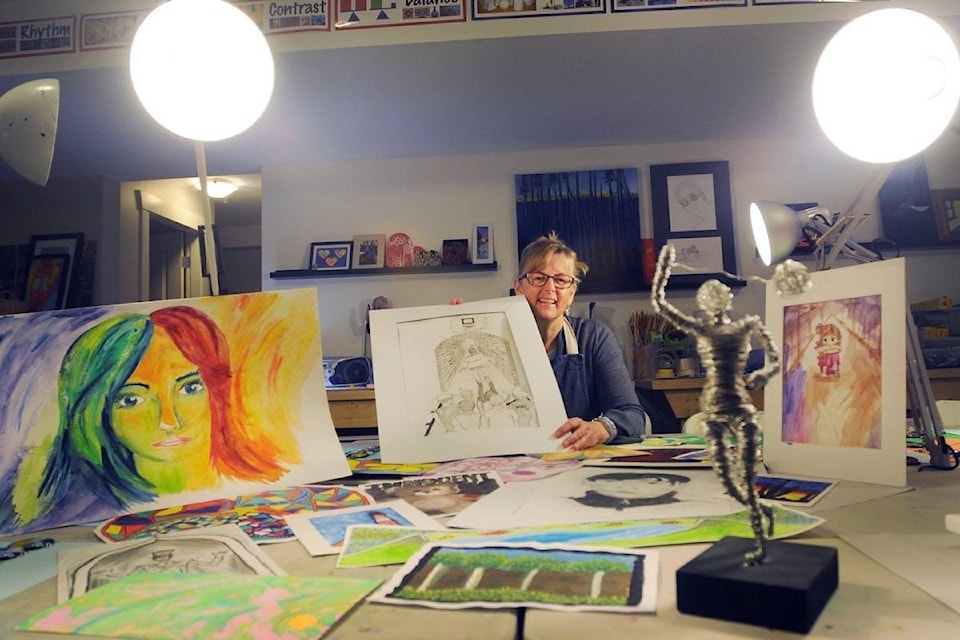Philippa Glossop’s art school students always show up to class wanting to do well, usually with preconceived notions of what they are going to create.
It might be a portrait or a landscape with a sunset, a barn or a tree.
One student, who sits down at one of the long lines of tables in ’s Maple Ridge home studio, begins to draw: a line.
However, the line is not right and the student, who is unable to move past this imperfection, becomes fixated on this fact. The student’s mood quickly turns dour, feeling inadequate. Self-esteem and motivation is lost.
Glossop often sees the anguish of a situation like this presented in a panic attack, where the student feels like their breathing is cut off, as they deal with feelings of fearfulness and .
And after 27 years as an art teacher, Glossop has noticed that she is seeing more and more students with these types of . Some have been diagnosed with the mental condition and others simply have anxiety at one level or another.
When she first started teaching art in Kamloops, she figures that maybe one in a class of 27 had some sort of anxiety issue. Now, she says, it’s more like three or four and sometimes even five children in a classroom that have an “unhealthy” level of anxiety.
“There’s a certain amount of stress in your life that is healthy. But these kids are experiencing something on the other side of that,” said Glossop.
So she started paying attention. She began by watching carefully for signs of what she calls “negative self-talk” – negative thoughts about themselves. She tries to pull them out of those thoughts right away.
Then she gives them tools – through art – to deal with those emotions.
Usually, she starts by asking them questions about what they are doing at the class and what is happening at that moment. Then she asks them what direction they see themselves going in, then assures them that she will help them get there.
One problem some of her students have is a notion that they can be a perfect painter without putting the hours in.
So, early in the class, they talk about not being good at things right away because they are learning and how to deal with their frustrations.
One tool that Glossop uses is turning a painting upside down.
“[Painting] a picture of a lion or an animal when your image is upside down, it’s not so much an animal anymore, you are just looking at shapes, you are looking at colour, you are looking at pattern, all the elements and principles of art and design, but in a way that it doesn’t stress you out,” she said.
Glossop stresses that she is not an art therapist, but instead uses her art as recreational therapy.
She has two undergraduate degrees from Queens University in Ontario, one in fine arts and the other in art history.
She completed her master’s degree in education at Thompson River University in 2014. Her thesis explored the relationship between self-compassion and creativity, called It’s Not Perfect, I Need To Start Again, a common refrain she hears from her students.
It surprises her that, as part of her thesis, she was working with children as young as five who had anxiety issues.
Over the years, she has found that children between eight and 12 years old have a tendency towards anxiety.
“I would say that I am a specialist with children with anxiety only because I’ve seen, over many years of teaching, I’ve seen this develop,” she said.
And she has become so good at helping them work through their issues that Maple Ridge-Pitt Meadows school district brings her into classrooms.
Most of the children she works with put pressure on themselves to excel, for perfection, that she feels is often passed from parent to child.
But by learning how to cope with their anxiety through art, her students are transferring that knowledge and using the same tools she is teaching them to deal with other issues at school, such as taking tests.
“We talk about planning and we talk about how to approach things and what happens if you start to feel inside that you are starting to get worried that it’s not working the way you want,” said Glossop.
“What do we do, we step back, we look at it, we talk about it, we take a breath, we count to 10,” she added.
In Glossop’s classes, students can paint or draw what they feel.
Lessons might be about colour, or what makes a good brush or a technique or something based on art history. Then it is up to her students to interpret the lesson in their art.
Another tool she teaches her students is to ask them what advice they would give a friend who couldn’t work through a problem. Because, she said, most people are harder on themselves than others, that they lack self-compassion.
“Think about what you would tell a friend and then tell it to yourself.”
mailto:cflanagan@mapleridgenews.com
Like us on and follow us on



